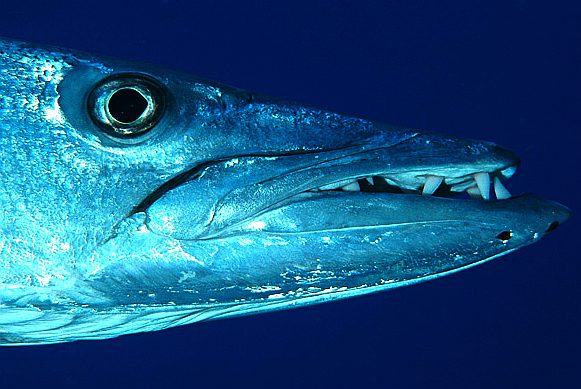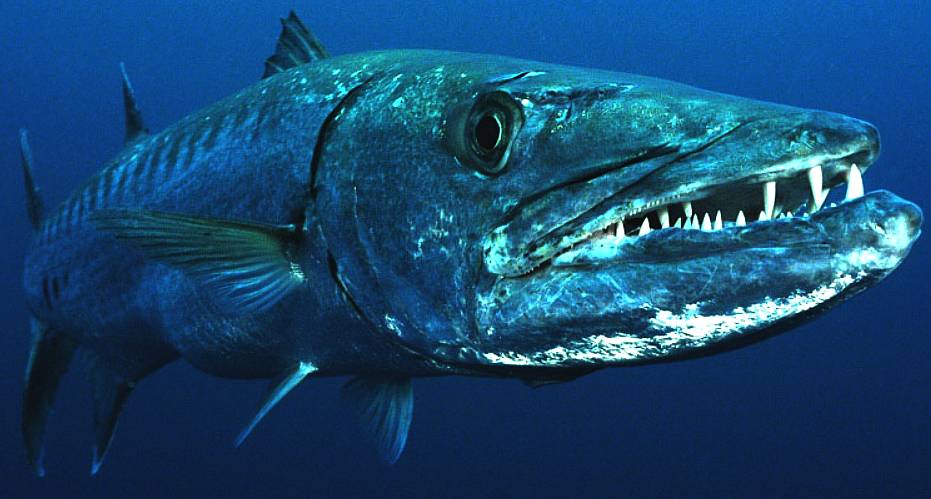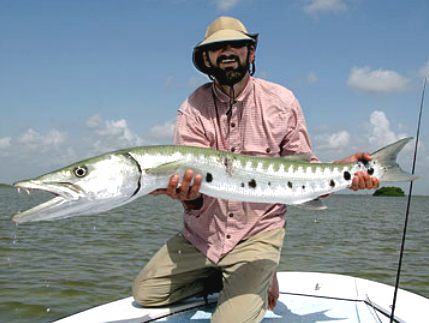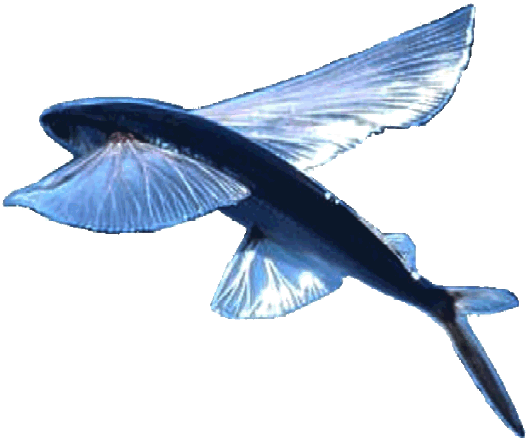|

The barracuda is a ray-finned fish known for its large size and fearsome appearance. Its body is long, fairly compressed, and covered with small, smooth scales. Some species can reach up to 2.1 m (6.9 ft) in length and 30 cm (12 in) in width. The barracuda is a saltwater fish of the genus Sphyraena, the only genus in the family Sphyraenidae, and is found in tropical and subtropical oceans worldwide.
Barracudas are voracious, opportunistic predators, relying on surprise and short bursts of speed (up to 27 mph (43 km/h)) to overtake their prey.
Adults of most species are more or less solitary, while young and half-grown fish frequently congregate. Barracuda prey primarily on fish (which may include some as large as themselves). They kill and consume larger prey by tearing chunks of flesh.

DESCRIPTION
Barracudas are elongated fish, pike-like in appearance, with prominent, sharp-edged, fang-like teeth, much like piranhas, all of different sizes, set in sockets of their large jaws. They have large, pointed heads with an underbite in many species. Their gill covers have no spines and are covered with small scales. Their two dorsal fins are widely separated, with the anterior fin having five spines, and the posterior fin having one spine and 9 soft rays. The posterior dorsal fin is similar in size to the anal fin and is situated above it. The lateral line is prominent and extends straight from head to tail. The spinous dorsal fin is placed above the pelvic fins and is normally retracted in a groove. The caudal fin is moderately forked with its posterior edged double-curved and is set at the end of a stout peduncle. The pectoral fins are placed low on the sides. Its swim bladder is large.
In most cases, a barracuda is dark blue, dark green, or gray on its upper body, with silvery sides and a chalky-white belly. Coloration varies somewhat between species. For some species, irregular black spots or a row of darker cross-bars occur on each side. Their fins may be yellowish or dusky. Barracudas live primarily in oceans, but certain species, such as the great barracuda, live in brackish water.
Some species grow quite large, such as the European barracuda, barracouta, or spet (S. sphyraena), found in the Mediterranean Sea and eastern Atlantic; the great barracuda, picuda or becuna (S. picuda), ranging on the Atlantic coast of tropical America from North Carolina to Brazil and reaching Bermuda. Other barracuda species are found around the world. Examples are the California barracuda (S. argentea), found from Puget Sound southwards to Cabo San Lucas, the Indian barracuda (S. jello), and the black-finned or Commerson's barracuda (S. commersoni), from the seas of India and the Malay Peninsula and Archipelago.

HUMANS
Like sharks, some species of barracuda are reputed to be dangerous to swimmers. Barracudas are scavengers, and may mistake snorkellers for large predators, following them in hopes of eating the remains of their prey. Swimmers have been reported being bitten by barracuda, but such incidents are rare and possibly caused by poor visibility. Large Barracuda can be encountered in muddy shallows on rare occasion. Barracudas may mistake things that glint and shine for prey. One incident reported a barracuda jumping out of water and injuring a kayaker, but a marine biologist at the University of Florida said the type of wound appeared to have rather been caused by a houndfish.
Handfeeding or touching large barracuda in general is to be avoided. Spearfishing around barracudas can also be dangerous, as they are quite capable of ripping a chunk from a wounded fish thrashing on a spear.
Diamond rings and other shiny objects have been known to catch their attention and resemble prey to them. Caution should be taken when swimming near mangrove coastlines by covering or removing such items.
POPULAR FISH:
Please
use the Index below to navigate the Animal Kingdom:-
|
AMPHIBIANS |
Such
as frogs (class: Amphibia) |
|
ANNELIDS |
As
in Earthworms (phyla: Annelida) |
|
ANTHROPOLOGY |
Neanderthals,
Homo Erectus (Extinct) |
|
ARACHNIDS |
Spiders
(class: Arachnida) |
|
BIRDS
|
Such
as Eagles, Albatross
(class: Aves) |
|
CETACEANS
|
such
as Whales
& Dolphins
( order:Cetacea) |
|
CRUSTACEANS |
such
as crabs (subphyla: Crustacea) |
|
DINOSAURS
|
Tyranosaurus
Rex,
Brontosaurus (Extinct) |
|
ECHINODERMS |
As
in Starfish (phyla: Echinodermata) |
|
FISH
|
Sharks,
Tuna (group: Pisces) |
|
HUMANS
-
MAN |
Homo
Sapiens THE
BRAIN |
|
INSECTS |
Ants,
(subphyla: Uniramia class: Insecta) |
|
LIFE
ON EARTH
|
Which
includes PLANTS
non- animal life |
|
MAMMALS
|
Warm
blooded animals (class: Mammalia) |
|
MARSUPIALS |
Such
as Kangaroos
(order: Marsupialia) |
|
MOLLUSKS |
Such
as octopus (phyla: Mollusca) |
|
PLANTS |
Trees
- |
|
PRIMATES |
Gorillas,
Chimpanzees
(order: Primates) |
|
REPTILES |
As
in Crocodiles,
Snakes (class: Reptilia) |
|
RODENTS |
such
as Rats, Mice (order: Rodentia) |
|
SIMPLE
LIFE FORMS
|
As
in Amoeba, plankton (phyla: protozoa) |
|
|
LINKS
http://en.wikipedia.org/wiki/Piranha
http://en.wikipedia.org/wiki/Flying_fish
http://en.wikipedia.org/wiki/Barracuda
https://en.wikipedia.org/wiki/Manta_ray
http://en.wikipedia.org/wiki/Bluefish
http://en.wikipedia.org/wiki/Tuna

|


